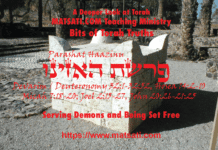In this week’s reading from Parashat VaYakhel (Shemot / Exodus 35:1-38:20) Moshe assembled the entire congregation of Yisrael and said אֲלֵהֶם אֵלֶּה הַדְּבָרִים אֲשֶׁר-צִוָּה יְהוָֹה לַעֲשֹת אֹתָם “These are the things that the Lord has commanded you to do.” (NASB) They are to keep the seventh day as holy to the Lord (Shabbat, 35:2). No work is to be done on the Shabbat. A תְּרוּמָה Terumah (contribution) is to be made to the Lord like it was described in Parashat Terumah (35:5). Gold, silver, bronze, blue, purple, and scarlet material, linen, goats hair, rams’ skins, porpoise skins, acacia wood, olive oil, incense, and onyx stones for the setting of the ephod and breastplate (35:5-9). Moshe describes the construction and all of the details of the Mishkhan (Tabernacle, 35:10-19). It says that כא וַיָּבֹאוּ כָּל-אִישׁ אֲשֶׁר-נְשָֹאוֹ לִבּוֹ וְכֹל אֲשֶׁר נָדְבָה רוּחוֹ אֹתוֹ הֵבִיאוּ אֶת-תְּרוּמַת יְהֹוָה לִמְלֶאכֶת אֹהֶל מוֹעֵד וּלְכָל-עֲבֹדָתוֹ וּלְבִגְדֵי הַקֹּדֶשׁ: 35:21 Everyone whose heart stirred him and everyone whose spirit moved him came and brought the Lord’s contribution for the work of the tent of meeting and for all its service and for the holy garments. (NASB) Moshe called Bazalel and Oholiab and every skilled person the Lord had gifted with the skills of a craftsman to begin the work of building the sanctuary (35:26-36:2). The people were so generous that Moshe needed to tell them to stop bringing the תְּרוּמָה (contribution) (36:6). The scripture details the construction of the curtains (36:9-18) and the construction of the walls of the Mishkhan (36:19-37). Construction of the Ark of the Covenant is detailed (37:1-15). The utensils used for the daily sacrifice were constructed (37:16) and the menorah was constructed from one piece of pure gold (37:17-22). The altar of incense was constructed from acacia wood and overlaid with pure gold (37:25-29). The altar for the burnt offering was constructed next (38:1-7) and it was overlaid with bronze and the laver was then constructed (38:8). The remainder of the Parashah details the construction of the court of the Tabernacle (38:38:9-20). Moshe gives an accounting of the materials used in the construction of the Mishkhan (Tabernacle) constructed by Betzalel and Oholiab. The priestly garments were also made by Betzalel and Oholiab consisting of (i) the ephod, (ii) the breastplate, (iii) the cloak, (iv) the crown, (v) the hat, (vi) the tunic, and (vii) the sash and breeches. Following the construction of the Mishkhan, Moshe assembles everything, anoints them with oil, and commissions Aaron and his sons into the priestly service. While reading the details of the construction of the Tabernacle, have you ever wondered why God chose to use pomegranates as a decoration for the priestly garments? Studying the Prophets, King Solomon also decorated parts of the first temple with sculpted pomegranates. What is the symbolic significance of the pomegranate? Read More here.








